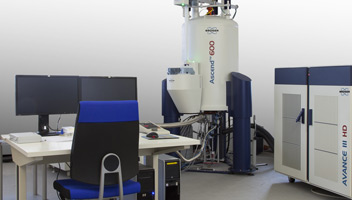HOW CAN WE HELP YOU? Call 1-800-TRY-CHOP
In This Section
Does a New Method Tackle the NMR Challenge of Large Proteins?

Researchers’ access to nuclear magnetic resonance (NMR) capabilities within the CHOP and Penn biomedical research communities recently expanded with the installation of a $1.5M state-of-the-art NMR system.
The findings:
While data generated using nuclear magnetic resonance (NMR) spectroscopy holds great promise, researchers are often frustrated by how laborious it can be to perform the analysis before they can begin to derive meaningful results. It is no secret to the research community that the process of identifying, or assigning, NMR signals to specific amino acid groups in a protein structure is cumbersome, and different laboratories use different procedures, each with their own limitations, according to Nikolaos Sgourakis, PhD, principal investigator. Dr. Sgourakis and colleagues developed a new procedure for recording and analyzing NMR data, methyl assignments using satisfiability (MAUS), that effectively tackles these challenges. Now, solving a problem that would normally take weeks of NMR machine and expert time can be accomplished in just a few days, including the time it takes to record the data.
Why it matters:
NMR can provide high-resolution, 3D structural information for proteins and other important therapeutic targets in a physiologically relevant, aqueous environment; however, due to technical limitations, applications of NMR have been limited to smaller-sized proteins, typically less than 150 amino acid residues. This is due to the fact that, while NMR spectra can be recorded by leveraging suitable chemical groups as probes (i.e., methyls) found on specific amino acids within protein molecules, the resulting data are too convoluted to interpret manually. Other efforts with software methods can make mistakes due to the complexity of the data and underlying assumptions used for analysis. As a result, the overall process is prohibitively time-consuming, often leading to errors that have precluded the use of NMR as a high-throughput technique to visualize larger protein targets, and to screen and identify novel compounds for drug development.
MAUS allows biomedical researchers to visualize protein molecules with atomic-detail accuracy, opening new possibilities in drug development. With MAUS, researchers can apply the analysis method to larger, more complex proteins to understand their interactions with other molecules and induced structural changes — both aspects that are critical for targeting proteins often deemed undruggable because their predominant structures offer limited surfaces for interactions with antibodies and small molecules. Guided by static snapshots of such systems, provided by X-ray crystallography and cryoelectron microscopy, NMR can provide critical insights on protein dynamics: atomic motions that may cause proteins to switch between a major and a transient, or “sparse,” structure, thereby exposing cryptic sites for drug targeting.
Who conducted the study:
Nikolaos Sgourakis, PhD, lead principal investigator in the Mechanistic Molecular Immunology Lab, led an interdisciplinary team of researchers from Children’s Hospital of Philadelphia, the University of California Santa Cruz, and Universidade Federal do Rio de Janeiro to develop MAUS. Members of the research team include first authors graduate student Santrupti Nerli, research associate Viviane De Paula, PhD, and postdoctoral fellow Andrew McShan, PhD. Their paper, which appears in Nature Communications, outlines a complete experimental sample preparation, data collection, processing and analysis protocol, and demonstrates its effectiveness on a range of important protein molecules, including a common form of the human leucocyte antigen, the therapeutic cytokine interleukin 2, and the Cas9 nuclease.
How they did it:
The team used a suite of NMR experiments recorded on two protein samples prepared using complementary isotopic labelling patterns. MAUS leverages nuclear Overhauser effect (NOE) data and a 3D structure of the protein of interest that can be accessed from the Protein Data Bank to provide robust resonance assignments, consistent with all the experimental inputs.
Using data recorded for targets with known assignments in the 10–45 kDa size range, MAUS outperforms existing methods by up to 25,000 times in speed while maintaining 100 percent accuracy. The research team derived de novo assignments for multiple Cas9 nuclease domains, demonstrating that the methyl resonances of multi-domain proteins can be assigned accurately in a matter of days, while reducing biases introduced by manual pre-processing of the raw NMR data. MAUS is openly available for academic users through an online webserver.
Quick thoughts:
Dr. Sgourakis noted the particular applications of NMR that would leverage MAUS aim to study larger, more complex protein molecules.
“This is important because the main limitation of NMR is the size of the molecules it can be used to study,” Dr. Sgourakis explained. “We can see larger, more complex molecules by NMR; it's just that the analysis of the resulting data becomes too convoluted to make it tractable in a lab, especially if you’re thinking about pursuing several targets in parallel.”
Typical NMR projects would involve a postdoc or a student making a protein in the lab and recording the data, then taking several weeks to months to make sense of it before being able to advance to studying the biology of interactions.
“Our method really helps overcome these barriers and addresses a critical need,” Dr. Sgourakis said.
What’s next:
Researchers’ access to NMR capabilities within the CHOP and University of Pennsylvania biomedical research communities expanded significantly in February with the installation of a $1.5M state-of-the-art NMR system, supported by a joint venture between CHOP Research Institute, Penn, and the National Institute of General Medical Sciences.
“I’m grateful for CHOP Research Institute leadership, particularly Bryan Wolf, MD, PhD, [executive vice president and chief scientific officer] as well as Kristen Lynch, PhD, chair of the department of Biochemistry and Biophysics at Penn, all of whom made this possible,” Dr. Sgourakis said.
Supported by MAUS, the new resource will enable studies on a range of biologically relevant protein systems toward developing more targeted therapies for the treatment of cancer and infectious diseases.
Where the study was published:
The paper appears in Nature Communications.


